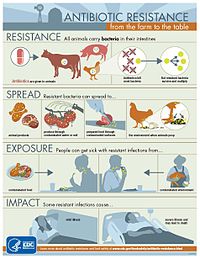
Photo from wikipedia
This study aimed to determine the percentage of colistin resistant and ESBL-producing Escherichia coli from clinically sick and healthy pigs and understand the molecular mechanisms underlying colistin resistance and ESBL… Click to show full abstract
This study aimed to determine the percentage of colistin resistant and ESBL-producing Escherichia coli from clinically sick and healthy pigs and understand the molecular mechanisms underlying colistin resistance and ESBL production. A total of 454 E. coli isolates from healthy pigs (n = 354; piglets, n = 83; fattening pigs, n = 142 and sows, n = 100) and sick pigs (n = 100) were examined for antimicrobial susceptibility, chromosomal and plasmid-mediated colistin resistance mechanisms and ESBL genes. The healthy (41%) and sick pig (73%) isolates were commonly resistant to colistin. Three mcr genes including mcr-1 (10.4%), mcr-2 (1.1%) and mcr-3 (45%) were detected, of which mcr-3 was most frequently detected in the healthy (33%) and sick pig (57%) isolates. Coexistence of mcr-1/mcr-3 and mcr-2/mcr-3 was observed in piglets (23%), fattening pig (3.5%) and sick pig (13%) isolates. Three amino acid substitutions including E106A and G144S in PmrA and V161G in PmrB were observed only in colistin-resistant isolates carrying mcr-3. The percentage of ESBL-producing E. coli was significantly higher in the sick pigs (44%) than the healthy pigs (19.2%) (P = 0.00). The blaCTX-M group was most prevalent (98.5%), of which blaCTX-M-14 (54.5%) and blaCTX-M-55 (42.9%) were predominant. The blaTEM-1 (68.8%) and blaCMY-2 (6.3%) genes were identified in ESBL-producers. All ESBL producers were multidrug resistant and the majority from piglets (97%), fattening pigs (77.3%) and sick pigs (82%) carried mcr gene (s). ESBL producers from piglets (n = 5) and sick pig (n = 1) simultaneously transferred blaTEM-1 (or blaCTX-M-55) and mcr-3 to Salmonella. In conclusion, pigs are important reservoirs of colistin-resistant E. coli that also produced ESBLs, highlighting the need for prudent and effective use of antimicrobials in pigs and other food-producing animals.
Journal Title: Scientific Reports
Year Published: 2022
Link to full text (if available)
Share on Social Media: Sign Up to like & get
recommendations!